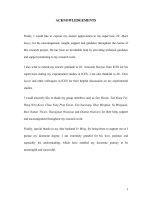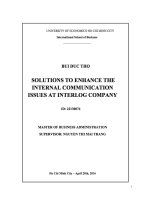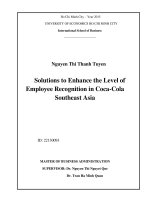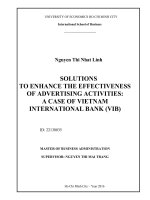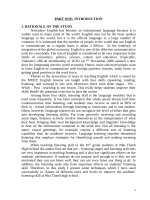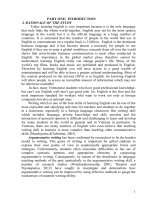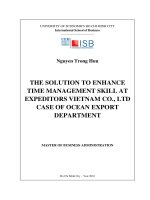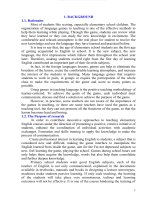Solution to enhance the internal communication issues interlog company
Bạn đang xem bản rút gọn của tài liệu. Xem và tải ngay bản đầy đủ của tài liệu tại đây (1.46 MB, 82 trang )
1
EXECUTIVE SUMMARY
The terminology “logistics” was first used in the late 19th century and for military
purposes during wars. Since the 1950s, logistics have grown gradually from the simplest
stage as first party logistics (1PL) to more complex stages such as third- party logistics
(3PL) and fourth-party logistics (4PL) nowadays. To date, Asia Pacific’s logistics sector
has been expanding rapidly together with economic growth; therefore the industry
landscape of Vietnam’s logistics sector is teaming with both opportunities and challenges.
The main drivers are the growth of GDP and import-export activities based on the
upcoming Trans-Pacific Partnership (TPP) that Vietnam has joined recently.
Inter Logistic Company is a small logistic firm with its head office located in Ho
Chi Minh City, Vietnam. They have built a powerful workforce with more than 100 full
time staffs and three members of Board of Directors (BoD), developed an official
network in three big cities in Northern, Central and Southern regions of Vietnam. In
reality, the high turnover rate at Interlog was increasing significantly in the last two
recent years from 2013 till now from 20 to 27 percent out of total. Especially, the Sales
Department is one of the most important departments at the company that accounted for
50% out of total. This rate is extremely high compared with the average rate in the same
industry and it strongly affects the expansion and development activities of the company
particularly before the Asean Economic Community (AEC) comes into effect and holds
immense potential for the region in many aspects including logistics service starting in
2016. Indeed, the AEC allows the free flow of goods, services and skilled labor across
2
the region so that the competition has become even harsher than before in several
industry sectors of Vietnam economy.
After conducting research on various viewpoints of several people at different
positions in the company by using in-depth interviews technique and collecting the
secondary information from some reliable sources both inside and outside company. The
author has noticed that there are some tentative problems that have directly affected the
employees such as lackluster motivation and promotion, the ineffective internal
communication between each other, and the heavy workload. Among these, the
ineffective internal communication between Sales and Custom Department is the most
serious issue because it comprises numerous causes such as inappropriate leadership
style, shortcoming in the managerial skills of mid-level managers, poor working
relationship etc.
Hence, this dissertation has come up with two main objectives: critically review the
vital factors that affect the high turnover rate of employees at Interlog Company and
recommend solutions to solve the core problem in order to improve the entire
organizational performance. All of these tentative solutions have carefully considered in
three vital elements: benefits, costs and feasibility, then finally the most appropriate one
is chosen to implement. In reality, the implementation plan breaks each solution into
identifiable steps, assigns each step to one or more divisions and suggests when each step
will be completed as well.
3
Table of Contents
EXECUTIVE SUMMARY ............................................................................................................ 2
LIST OF FIGURES ........................................................................................................................ 6
LIFT OF TABLES .......................................................................................................................... 6
ACKNOWLEDGEMENT .............................................................................................................. 7
VIETNAM’S LOGISTICS OVERVIEW ............................................................................... 8
I.
1.1
General Overview ............................................................................................................ 8
Figure 1: Number of 3PL Members of Vietnam Logistics Association (VLA) ............................. 8
Figure 2: The Growth Rate of Vietnam’s Logistics Market ........................................................... 9
Figure 3: Types of Logistics Service .............................................................................................. 9
Table 1: Types of Transportations in Global ................................................................................ 10
Table 2: Transportation Infrastructure in Vietnam ....................................................................... 11
1.2
II.
Limitations and Obstacles .............................................................................................. 11
PROBLEM CONTEXT ..................................................................................................... 13
2.1
Company Background .................................................................................................... 13
2.2
Main Achievements........................................................................................................ 14
2.3
Organizational Structure ............................................................................................... 15
Figure 4: Organizational Structure Chart ...................................................................................... 15
III.
3.1
PROBLEM IDENTIFICATION ........................................................................................ 16
Problem Symptom .......................................................................................................... 16
Table 3: The Overall Turnover Rate in year 2013 and 2014 ........................................................ 17
Table 4: Elements Contributing to Losses Related with Employee High Turnover..................... 18
Table 5: The Specific Turnover Rate of Each Department at Interlog Company ........................ 20
Table 6: List of Literature Reviews .............................................................................................. 21
3.2
The Lackluster Motivation and Promotion .................................................................... 26
4
Table 7: The Comparison Between Annual Base Salary Increase and Inflation Rate.................. 27
Table 8: Vietnam’s Logistic Average Salary ................................................................................ 28
3.3
The Ineffective Internal Communication ....................................................................... 30
3.4
The Heavy Workload ..................................................................................................... 34
Table 9: The Number of Male and Female Left the Company in 2013 & 2014........................... 34
Figure 5: Results of Incident Analysis at Interlog Company ........................................................ 37
3.5
IV.
The Real Core Problem .................................................................................................. 38
SOLUTIONS ..................................................................................................................... 44
Table 11: The Internal Communication Strategy Suggestion ....................................................... 45
V.
IMPLEMENTATION ........................................................................................................ 53
VI.
CONCLUSION .................................................................................................................. 60
VII.
SUPPORTING INFORMATION .................................................................................. 61
7.1 Research Methodology ....................................................................................................... 61
7.2 Report of Transcript ............................................................................................................ 62
7.3 Detailed Transcript.............................................................................................................. 64
REFERENCES ............................................................................................................................. 75
5
LIST OF FIGURES
Figure 1. Number of 3PL Members of Vietnam Logistics Association (VLA)
Figure 2. The Growth Rate of Vietnam’s Logistics Market
Figure 3. Types of Logistics Service
Figure 4. Organizational Structure Chart
Figure 5. Results of Incident Analysis at Interlog Company
LIFT OF TABLES
Table 1. Types of Transportations in Global
Table 2. Transportation Infrastructure in Vietnam
Table 3. The Overall Turnover Rate in year 2013 and 2014
Table 4. Elements Contributing to Losses Related with Employee High Turnover
Table 5. The Specific Turnover Rate of Each Department at Interlog Company
Table 6. List Paper Research Topic
Table 7. The Comparison Between Annual Base Salary Increase and Inflation Rate
Table 8. Vietnam’s Logistic Average Salary
Table 9. The Number of Male and Female Left The Company in 2013 and 2014
Table 10. List of Alternative Solutions
Table 11. The Internal Communication Strategy Suggestion
6
ACKNOWLEDGEMENT
I would like to extend the warmest thanks and a debt of gratitude to the following
people who have truly made vital contribution to the completion of this dissertation.
Indeed, without them I definitely would not have written this paper.
Firstly, I would like to express my truthful thanks to my advisor, Mrs. Nguyen Thi
Mai Trang for her kindly guidance and deeply encouragement from the beginning to the
ending.
Secondly, special thanks to Mrs. Thao Linh, Ms. Bao Ngoc, Mrs. Thanh Hoa, Mr.
Phuoc Loc, Ms. Hoang Linh, Mrs. Minh Nguyet, Mrs. Ngoc Diep for their valuable and
precisely information during the information collection period and in-depth interviews at
the International Logistic Company.
Last but not least, a big thank-you to all of my family’s members and my close
friends who made invaluable contributions. I hope to receive more support from all of
them in the future.
7
I.
VIETNAM’S LOGISTICS OVERVIEW
1.1
General Overview
Nowadays, Vietnam’s logistics sector is expected to grow at a Compound Annual
Growth Rate (CAGR) of 27% from 2013 to 2020 with increasing 3PL – outsourcing
needs from both existing and new multinational corporations as well. In fact, the 3PL
industry in Vietnam is growing quick in terms of revenues and active firms, particularly
in the Southern region. In addition, the 3PL revenues are projected to achieve 11.8 billion
USD in 2020 with a CAGR at 25.8% from 2007 to 2020. Indeed, the number of 3PL
members of Vietnam Logistics Association increased tremendously from four members
in the period of 1994 to 1997 to 275 members in June 2014.
Figure 1: Number of 3PL Members of Vietnam Logistics Association (VLA)
8
Figure 2: The Growth Rate of Vietnam’s Logistics Market
Logistics industry typically comprises of three key elements as the following:
Infrastructure: ports, terminals, railway, and roads
Operations: warehousing, storage, local distribution and trucking
Services: freight forwarders and customs brokers
The main objective of logistics is to move goods from their point of beginning to the
point of consumption while conforming to customer requirements.
Figure 3: Types of Logistics Service
9
Among the above several types of logistics, the most common one is transportation
(on the right-hand side), which occupies about 40% to 60% of logistics cost.
Transportation can take the form of many combinations of modes and routes. Basically,
there are five routes in worldwide:
Table 1: Types of Transportations in Global
Notably, Vietnam enjoys a good location within the region and is equipped with a
huge transport infrastructure. As people may know, it has more than 3,000 kilometers of
coastline, is situated nearby vital international shipping lanes; 49 seaports, classified in
six groups according to their geographic location along the coastlines (Vietnam Marine
Administration – VMA, 2013); and 206 thousand kilometers of roadways (GSO, 2012).
Nonetheless, the quality of the transport infrastructure is still low compared with the good
geographical condition. Vietnam was ranked 44th in infrastructure Logistics Performance
Index (LPI), which is much lower than Malaysia (26th), China (23rd) and Thailand
(30th). Additionally, in the “Global Competitiveness Report” of WEF, Vietnam was
ranked low in terms of quality of transport infrastructure but did show a bit of
improvements from 2012 to 2014.
10
Table 2: Transportation Infrastructure in Vietnam
1.2
Limitations and Obstacles
Presently, the World Bank assesses that the logistics infrastructure of Vietnam may
be able to accommodate fast growth but there are still many limitations. The limitations
come from the prevalence of unpredictability in the supply chains as follows:
(i)
Cumbersome and inconsistently applied government regulations
(ii)
Facilitation payments to avoid delay
(iii)
Isolation in planning and executing transportation infrastructure projects
without considering supply – demand
Despite several inefficiencies and weaknesses, Vietnam’s logistics are now
becoming a major driver in the development of the nation’s economic development since
Vietnam’s logistics cost occupies about 25% of GDP. It is expected to grow at a CAGR
of 27% from 2013 to 2020, which is in line with the rising trend of GDP and import –
export value. The establishment of the Trans-Pacific Partnership and other free trade
11
agreements such as the Vietnam – EU, NAFTA, and AFTA etc. coming into effect in the
near future will serve to increase Vietnam’s international trade including the logistics
sector.
Nevertheless, 70% to 80% of the logistics market currently belongs to 25 big
foreign companies among the 1,200 logistics companies that operate in Vietnam.
Likewise, as some segments of the logistics market opens fully to foreign companies in
accordance with WTO commitments; the growth opportunity for Vietnamese firms will
narrow down significantly. In order to increase competitiveness as well as improve the
capability of the logistics sector, the Vietnamese government has drafted a detailed
master plan for each type of transportation mode and logistics services. It definitely takes
time and cost to transform the master plan into the real life for Vietnam logistics firms.
12
II.
PROBLEM CONTEXT
2.1
Company Background
Inter Logistic Company with its head office located in Ho Chi Minh City was
established in August 2005. They have built a powerful workforce with more than 100
full time staffs and three members of Broad of Directors (BoD), developed an official
network in three big cities in Northern, Central and Southern regions of Vietnam. The
mission of the company is to create the effective supply chain that brings benefits to
customers and community (Interlogistic.com.vn, 2012).
Name of Company: International Logistics Joint Stock Company
Short name: Interlog Company
Head office: 5th Floor, Saigon Port Building, 03 Nguyen Tat Thanh St., W.12,
Dist. 4, HCMC.
Telephone: +84.8.39435899
Fax: +84.8.39435898
Tax code: 0303957341
Email:
Website: www.interlogistics.com.vn
In the next 5 years, Interlog has oriented to become the leading supply chain
innovator not only in Vietnam but also in Indochina area. Over 10-year development,
they have achieved several significant milestones, including:
2005: Established Interlog Head Office; Achieved ISO 9001:2000
13
2006: Established Interlog-Danang Agency
2007: Achieved Vietnam Excellent Brand Certificate, which was organized by
Ministry of Trade and Vietnam Economic Times
2008: Became agent of PCI (Pacific Concord INTL) and to be approved as an
Official Licensed Customs Broker by Vietnam Customs General Agency
2011: Established Interlog-Haiphong Agency and became the partner of AGS
(AGS World Transport) in Vietnam
2012: Established Interlog-Hanoi Branch
2014: Establishing NhonTrach Depot-Dong Nai province
2.2
Main Achievements
Became an official member of International Forwarders Association FIATA and
Association of Forwarding and Logistics Vietnam VIFFAS
Became an official member of Chamber of Commerce and Industry of Vietnam
VCCI.
Achieved Excellent Brand Award by the Vietnam Economic Times 2005 certified.
InterLog efforts are striving to become one of the service providers of logistics –
(Logistics Provider) first in Vietnam and Indochina specializing in service "onestop" for clients and packages.
14
2.3
Organizational Structure
Interlog sets up its organizational structure into particular departments that run
each part of every shipment from customers. The organization system of Interlog
comprises of Sales Department and Expert Bureau Department. In details, Sales Division
contains three segments of Export, Import and Domestics shipments meanwhile Expert
Bureau Department gets involve in documents, customs, trucking and warehousing etc.
Figure 4: Organizational Structure Chart
This organizational structure presents that the General Director (GD) has to
directly take responsibility six out of twelve departments meanwhile the sole Deputy
Director has to take care five departments in the company. This is a huge workload for
both two of them and they may not be able to closely monitor each department so that the
company needs additional Deputy Director to share the workload.
15
III. PROBLEM IDENTIFICATION
In order to understand deeply the real problem that happens at the company, the
writer would like to reveal the symptom and critical evidences as the following:
3.1
Problem Symptom
In today’s competitive environment, the rapidly changing and increasingly
connected modern society has made employees one of the most important strategic
constituencies of organizations (Kim & Rhee, 2011). On the one hand, employees are the
organization’s
production
force,
which
directly
contributes
to
organizational
performance. On the other hand, employees are corporate ambassadors and brand
advocates that represent the organization to external stakeholders (i.e., customers and
stockholders) both online and off-line. Therefore, satisfying employee and organization
relationships could not only boost employee productivity but also help create a critical
and cost efficient workforce that cultivates quality external relations and protects the
organization’s invisible assets such as reputation (Berger, 2008). Likewise, delivering
high quality services and maintaining customers satisfied are mostly regarded as crucial
elements for increasing a sustainable advantage. Pertaining to Osterman (2006),
workforces with a high level of guarantee to the business definitely have a stronger sense
of belonging. They are willing to learn new skills, share knowledge, provide ideas and
exceedingly pay more attention to quality and output as well. In addition, the
commitment related literature (Mowday, Porter, & Steers, 1979) implied that employee
16
performance and job satisfaction are intensely interrelated to the satisfaction of employee
needs in terms of economic and non-economic.
Here is the turnover incident that happens in the Interlog Company. These
employees worked at different positions in the company such as mid-level manager,
assistant and staffs. There were 16 out of 82 people in 2013 and 25 out of 92 people in
2014 left the company that account about 20 to 27 percent out of total employees based
on the annual report of Human Resource (HR) Department. In fact, this number is
considered as a high turnover rate for a small logistics service company in Vietnam since
the average turnover rate in 2014 is approximately 10% (Gioi, 2015).
Table 3: The Overall Turnover Rate in year 2013 and 2014
Among these departing employees, the turnover rate of Sales Department
accounted for 50% out of total and this number is quite high for one of the most
important departments at the company. This department comprises of four divisions:
Interconsol, Agents Development, Sales and Supply Chain Management and they are the
main sources to bring back the revenue for the company so far.
17
Academically, employee turnover is well defined as the movement of employees
across the labor market; between firms and positions (Ongori, 2007). A focused
definition focusing on a single organization proposed by Price (2001) explains turnover
as the movement of a worker over the membership boundaries of an organization.
Chikwe (2009) and Cho, Woods, Jang and Erdem (2006) claim, however, that the
definition of turnover refers to the replacement of an employee who left the organization
with a newly hired employee. On the flip side, turnover is only completed once a
replacement to fill the open vacancy is successfully recruited. A degree of employee
turnover is beneficial to an organization as new talent provides new perspectives and
skills. Nonetheless, when turnover cost surpasses the beneficial value of new employees,
organizational effectiveness declines gradually.
Table 4: Elements Contributing to Losses Related with Employee High Turnover
Types
Separation Cost
Elements
Exit interviews cost
Administrative functions linked to termination
Separation / compensation pay
Substitution Cost
Advertising position availability in various media channels
Placement test and entrance interviews
Holding decision-making meetings
Training & Coaching
Norms of conduct and performance
Cost
Publicizing relevant information for organizational socialization
Joining on the job training activities
(Source: Own Research)
18
The turnover rate can be measured and quantified by dividing the number of
employees leaving the organization over a specific period by the average number of
employees employed in that same period, multiplied by a hundred (Price, 2001). This
method is not used often as it does not distinguish between individuals that leave
voluntarily and those employees who are asked to leave (Msomi, 2010). According to
Perez (2008), intention to leave an organization is strongly influenced by a group of
organizational factors. Organizational influences include job stressors, organizational
culture, management relationships, and support systems. All of these factors contribute to
the decision process of terminating one’s services with an organization. In reality,
Huselid (1995) found that a high turnover rate is strongly connected to negative effects in
organization such as low yield, higher cost in hiring and coaching new people (Rousseau,
1984) and weak future performance as well (Baron, Hannan and Burton, 2001). Thus,
this is a bad symptom for any company that wants to enlarge and develop consistently
with the high turnover rate as above.
Here are some potential causes that directly affect the intention to leave of employees
particularly at the Sales Department of Interlog Company. The approach to study the
problem is most likely based on qualitative method particularly in-depth interview and
the secondary data from the annual reports of HR, Finance Departments and other outside
sources. Notably, a sample of eight people who are mid-level managers and experienced
employees at Interlog Company was targeted for in-depth interviews. These people have
the experience and knowledge to evaluate the current situations at the company.
19
Table 5: The Specific Turnover Rate of Each Department at Interlog Company
(Source: All of the data is gathered from Annual Human Resource report of year 2013 & 2014)
20
All of the literature reviews in this table below will be used in order to find out the
tentative problems in the Interlog Company. Even though some of theories are not quite
up to dated, they are still very useful sources for the author.
Table 6: List of Literature Reviews
No
01
02
Author
Nicholas,
Michel & Janet
(2008). The
Effect of
Management
Commitment to
Service Quality
on Frontline
Employees’ Job
Attitudes,
Turnover
Intention.
Journal of
Strategic
Marketing (Vol.
16, No. 5,
December)
Jing, Keng &
Choong (2011).
The relationship
between peoplerelated total
quality
management
practices, job
satisfaction and
turnover
intention.
African Journal
Antecedents
- Training
- Empowerment
- Employee Rewards
- Supportive
Management
- Servant Leadership
- Service Technology
- Organizational
Commitment
- Leadership
- Training and
Development
- Employee
Empowerment
- Employee Involvement
- Teamwork
- Job Satisfaction
Consequences
-
Turnover
Intention
-
Turnover
Intention
Findings
The organizational
commitment becomes
an insignificant
predictor of turnover
intention when the
effect of job satisfaction
is taken into
consideration and that
this is consistent with
longitudinal research
indicating that job
dissatisfaction causes
turnover.
The study results also
suggest that training,
employee rewards,
supportive management,
servant leadership and
service technology
jointly affect to the job
satisfaction and
organizational
commitment.
This study shows these
crucial factors of
leadership, level of
training and
development, degree of
employee
empowerment, extent of
employee involvement,
level of teamwork as
well as the impact of
reward and recognition
in increasing the job
21
03
04
05
of Business
Management
(Vol.5, No. 15)
Douglas (2006).
Organizational
Commitment,
Job Satisfaction
and Turnover
Intention of
Missionaries.
Journal of
Psychology and
Theology (Vol.
34, No. 4)
Ceyda (2014).
Impact of fit,
involvement,
and tenure on
job satisfaction
and turnover
intention. The
Service
Industries
Journal (Vol.
34, No. 14)
Ahmad,
Mohamad,
Ahamd, MOhd
and Abang
(2012). The
- Age
- Tenure
- Support by Leadership
- Communication
Openness
- Job Satisfaction
- Affective
Organizational
Commitment
- Age
- Gender
- Education Level
- Organizational Tenure
- Income
- Job Satisfaction
-Extrinsic Job
Satisfaction (Working
Condition-SupervisorCo-Worker)
-
Turnover
Intention
-
Turnover
Intention
-
Turnover
Intention
satisfaction and
turnover intention
among the employees.
The results support that
tenure (not age) is the
more important factor in
terms of organizational
commitment, job
satisfaction and
turnover intention. The
affective organizational
commitment plays a
mediating role between
job satisfaction and
turnover intention rather
than job satisfaction.
According to the
findings of this study,
longer tenured, highly
job-involved employees
need to be prioritized to
benefit from the job
design programs. The
high organizational
costs associated with
employee turnover in
service industries, the
retention of these
valuable employees is
also critical for the
transfer of accumulated
knowledge and skills to
new employees. Both
recruiters and applicants
to develop a common
understanding of the
basic job attributes at
the beginning of the
employment period
Both forms of job
satisfaction (intrinsic
and extrinsic
satisfaction) have
inverse relationship on
22
relationship
between Job
- Intrinsic Job
Satisfaction and Satisfaction (Work
Turnover
Value)
Intention.
American
Journal of
Applied
Sciences (Vol. 9,
No. 9)
06
Steven, Barbara,
Helen & Gino
(2004). Internal
communication
issues in an IT
engineering
department. An
International
Journal (Vol. 9,
Issue 1)
- Organizational
Procedures/Bureaucracy
- Workload
- Training
- Management
Commitment
- Rewards
- Internal
Communication
Issues
employees’ turnover
intentions. However it is
found that in this
research, the intrinsic
satisfaction has
significantly inverse
correlated with turnover
intention as compared to
the extrinsic
satisfaction. That means
the extrinsic satisfaction
founded to have less
influence with negative
relationship on turnover
intention
The mean for
organizational
procedures/bureaucracy
is a tie for the highest
dissatisfaction with the
amount of red tape and
bureaucracy inhibiting
productivity.
The mean for workload
indicates that the time
pressures/demands of
the job are not at a
reasonable level.
The mean for training is
high suggesting that
organizational members
believe that they have
not been adequately
trained in dealing with a
wide range of customer
problems required to
perform their duties
efficiently.
The organizational
members do not
perceive the actions of
management as
demonstrating their
commitment to
23
achieving the goals and
objectives of the
company.
The mean for rewards
suggests the
organizational members
are not sufficiently
rewarded nor
recognized for actions.
07
08
Millissa &
Cheung (2010).
Management
commitment to
service quality
and
organizational
outcomes. An
International
Journal (Vol.
20, Issue 3)
Gianluca (2014).
Does internal
communication
to generate trust
always increase
commitment?
An International
Journal (Vol.
19, Issue 1)
- Management’s service
vision
- Management’s
personal involvement
- Empowerment
- Job Competence
- Job Autonomy
- Trust
- Loyalty
- Empowerment
- Identity
- Control
- Commitment
- Employee’s Job
Satisfaction
- Internal
Communication
Issues
The management
commitment is
positively related to
effective employee
involvement, and this
involvement is
positively associated
with employees’ job
satisfaction. In addition,
effective employee
involvement fully
mediates the
relationship between
management
commitment to service
quality and
organizational outcomes
Internal communication
can be considered as
just one among many
possible solutions to be
used to increase
commitment, but not the
only one.
The literature highlights
that internal
communication acts as a
lever to generate
employee trust
relationships.
What becomes
important to increase
commitment is therefore
the relationship between
24
09
10
Gawie (2014).
Investigating
High Turnover
Intention and A
Diminished
Level of
Organizational
Commitment as
Antecedents.
Faculty of
Economic and
Management
Sciences at
Stellenbosch
University,
South Africa.
Ning (2004).
Antecedents and
Consequences
of Role Stress In
Hospitality
Industry.
Department of
Management
and
Organizational
National
University of
Singapore.
- Job Satisfaction
- Organizational Climate
- Commitment
- Individual Factor (Selfefficacy)
- Job Factors (Task
Autonomy, Task
Uncertainty)
- Job Satisfaction
-
Turnover
Intention
- Intention to Quit
management and single
employee, the
combination of
information that
management provides to
employees
All three mindsets of
organizational
commitment (affective,
normative and
continuance) predict
turnover intention. The
practical implication of
these findings can assist
management in
enhancing an array of
work behaviors such as
job performance, work
attendance and
organizational
citizenship, and also
reduce turnover rate.
Task Uncertainty will
lead to employees’
lower job satisfaction
and higher quit intention
due to the mediation
effect born by role
ambiguity.
It shows that the
relationship between
task uncertainty and role
conflict would be
positive for low selfefficacy employees.
Employees are
supposed to be able to
lower their job stress
when they have the
decision power on their
jobs.
25
